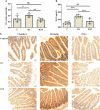Lactobacillus johnsonii YH1136 plays a protective role against endogenous pathogenic bacteria induced intestinal dysfunction by reconstructing gut microbiota in mice exposed at high altitude
- PMID: 36304467
- PMCID: PMC9592553
- DOI: 10.3389/fimmu.2022.1007737
Lactobacillus johnsonii YH1136 plays a protective role against endogenous pathogenic bacteria induced intestinal dysfunction by reconstructing gut microbiota in mice exposed at high altitude
Abstract
Background: Intestinal microbiota plays an important role in maintaining the microecological balance of the gastrointestinal tract in various animals. Disturbances in the intestinal microbiota may lead to the proliferation of potentially pathogenic bacteria that become the dominant species, leading to intestinal immune disorders, intestinal inflammation, and other intestinal diseases. Numerous studies have been confirmed that high-altitude exposure affects the normal function of the intestine and the composition of the intestinal microbiota. However, it is still necessary to reveal the changes in intestinal microbiota in high-altitude exposure environments, and clarify the relationship between the proliferation of potentially pathogenic bacteria and intestinal injury in this environment. In addition, explored probiotics that may have preventive effects against intestinal diseases.
Methods and results: C57BL/6 mice were randomly divided into three groups, a high-altitude group (HA), control group (C), and high-altitude probiotic group (HAP). The HA and HAP groups were subjected to hypoxia modeling for 14 days in a low-pressure oxygen chamber with daily gavage of 0.2 mL of normal saline (HA) and Lactobacillus johnsonii YH1136 bacterial fluid (HAP), while the control group was fed normally. L. johnsonii YH1136 was isolated from feces of a healthy Tibetan girl in Baingoin county, the Nagqu region of the Tibet Autonomous Region, at an altitude of 5000 meters. Our observations revealed that gavage of YH1136 was effective in improving the damage to the intestinal barrier caused by high-altitude exposure to hypoxic environments and helped to reduce the likelihood of pathogenic bacteria infection through the intestinal barrier. It also positively regulates the intestinal microbiota to the extent of Lactobacillus being the dominant microbiome and reducing the number of pathogenic bacteria. By analyzing the expression profile of ileal microRNAs and correlation analysis with intestinal microbiota, we found that Staphylococcus and Corynebacterium1 cooperated with miR-196a-1-3p and miR-3060-3p, respectively, to play a regulatory role in the process of high-altitude hypoxia-induced intestinal injury.
Conclusion: These findings revealed the beneficial effect of L. johnsonii YH1136 in preventing potential endogenous pathogenic bacteria-induced intestinal dysfunction in high-altitude environments. The mechanism may be related to the regulation of intestinal injury from the perspective of the gut microbiota as well as miRNAs.
Keywords: Lactobacillus johnsonii; high-altitude exposure; intestinal microbiota; miRNA; probiotic.
Copyright © 2022 Wan, Zhang, Jia, Qin, Sun, Xin, Zeng, Jing, Fang, Pan, Zeng, Bai, Wang, Ma and Ni.
Conflict of interest statement
HW was employed by the Guangzhou Beneco Biotechnology Co., Ltd. The remaining authors declare that the research was conducted in the absence of any commercial or financial relationships that could be construed as a potential conflict of interest.
Figures









Similar articles
-
Lactobacillus Johnsonii YH1136 alleviates schizophrenia-like behavior in mice: a gut-microbiota-brain axis hypothesis study.BMC Microbiol. 2025 Apr 2;25(1):191. doi: 10.1186/s12866-025-03893-w. BMC Microbiol. 2025. PMID: 40175911 Free PMC article.
-
Lactobacillus johnsonii HL79 modulates the microbiota-gut-brain axis to protect cognitive function in mice chronically exposed to high altitude.Front Microbiol. 2025 Mar 7;16:1561400. doi: 10.3389/fmicb.2025.1561400. eCollection 2025. Front Microbiol. 2025. PMID: 40124891 Free PMC article.
-
Preventive effect of Lactobacillus johnsonii YH1136 against uric acid accumulation and renal damages.Front Microbiol. 2024 Apr 16;15:1364857. doi: 10.3389/fmicb.2024.1364857. eCollection 2024. Front Microbiol. 2024. PMID: 38690361 Free PMC article.
-
Immunology and probiotic impact of the newborn and young children intestinal microflora.Anaerobe. 2011 Dec;17(6):369-74. doi: 10.1016/j.anaerobe.2011.03.010. Epub 2011 Apr 16. Anaerobe. 2011. PMID: 21515397 Review.
-
High-altitude-induced alterations in intestinal microbiota.Front Microbiol. 2024 May 9;15:1369627. doi: 10.3389/fmicb.2024.1369627. eCollection 2024. Front Microbiol. 2024. PMID: 38784803 Free PMC article. Review.
Cited by
-
Gut microbiota contributes to high-altitude hypoxia acclimatization of human populations.Genome Biol. 2024 Aug 28;25(1):232. doi: 10.1186/s13059-024-03373-w. Genome Biol. 2024. PMID: 39198826 Free PMC article.
-
Review of yeast culture concerning the interactions between gut microbiota and young ruminant animals.Front Vet Sci. 2024 Mar 1;11:1335765. doi: 10.3389/fvets.2024.1335765. eCollection 2024. Front Vet Sci. 2024. PMID: 38496306 Free PMC article. Review.
-
Intestinal oxygen utilisation and cellular adaptation during intestinal ischaemia-reperfusion injury.Clin Transl Med. 2025 Jan;15(1):e70136. doi: 10.1002/ctm2.70136. Clin Transl Med. 2025. PMID: 39724463 Free PMC article. Review.
-
Identification of immune-associated genes with altered expression in the spleen of mice enriched with probiotic Lactobacillus species using RNA-seq profiling.Anim Biosci. 2025 Feb;38(2):336-349. doi: 10.5713/ab.24.0280. Epub 2024 Aug 26. Anim Biosci. 2025. PMID: 39210803 Free PMC article.
-
Korean red ginseng extract prevents bone loss in an oral model of glucocorticoid induced osteoporosis in mice.Front Pharmacol. 2024 Mar 12;15:1268134. doi: 10.3389/fphar.2024.1268134. eCollection 2024. Front Pharmacol. 2024. PMID: 38533264 Free PMC article.
References
-
- Al-Sadi R, Nighot P, Nighot M, Haque M, Rawat M, Ma TY. Lactobacillus acidophilus induces a strain-specific and toll-like receptor 2-dependent enhancement of intestinal epithelial tight junction barrier and protection against intestinal inflammation. Am J Pathol (2021) 191(5):872–84. doi: 10.1016/j.ajpath.2021.02.003 - DOI - PMC - PubMed
Publication types
MeSH terms
Substances
LinkOut - more resources
Full Text Sources
Other Literature Sources

